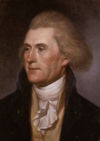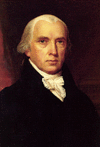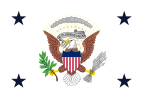- George Clinton (vice president)
-
George Clinton 
4th Vice President of the United States In office
March 4, 1805 – April 20, 1812President Thomas Jefferson
James MadisonPreceded by Aaron Burr Succeeded by Elbridge Gerry 1st Governor of New York In office
July 30, 1777 – June 30, 1795Lieutenant Pierre Van Cortlandt Succeeded by John Jay In office
July 1, 1801 – June 30, 1804Lieutenant Jeremiah Van Rensselaer Preceded by John Jay Succeeded by Morgan Lewis Personal details Born July 26, 1739
Little Britain, New YorkDied April 20, 1812 (aged 72)
Washington, D.C.Nationality American Political party Democratic-Republican Spouse(s) Sarah Cornelia Tappen Children Catharine Clinton
Cornelia Tappen Clinton
George Washington Clinton
Elizabeth Clinton
Martha Washington Clinton
Maria ClintonReligion Presbyterian Signature 
Military service Service/branch British Army
American MilitiaRank Lieutenant
Brigadier GeneralBattles/wars French and Indian War
American Revolutionary WarGeorge Clinton (July 26, 1739 – April 20, 1812) was an American soldier and politician, considered one of the Founding Fathers of the United States. He was the first Governor of New York, and then the fourth Vice President of the United States (1805–1812), serving under Presidents Thomas Jefferson and James Madison. He and John C. Calhoun are the only persons to serve as Vice-President under different U.S. Presidents.
Contents
Early life and participation in the Revolution
His political interests were inspired by his father, Charles Clinton, who was an English immigrant to Little Britain, New York and a member of the New York colonial assembly. George Clinton was the brother of General James Clinton and the uncle of New York's future governor, DeWitt Clinton.
At 18, he enlisted in the British Army to fight in the French and Indian War, eventually rising to the rank of lieutenant. He subsequently studied law, became clerk of the court of common pleas and served in the colonial assembly.
He was known for his hatred of Tories[1] and used seizure and sale of Tory estates to help keep taxes down. A supporter and friend of George Washington, he supplied food to the troops at Valley Forge, rode with Washington to the first Inauguration and gave an impressive dinner to celebrate it.
Political career
In 1759 he was appointed County Clerk for Ulster County, New York, a position he held for the next fifty-two years.[2] He was a member of the New York Provincial Assembly for Ulster County from 1768 to 1776. He became the first elected Governor of New York in 1777, and was re-elected five times, serving until 1795.
In 1783, at Dobbs Ferry, Clinton and Washington negotiated with General Sir Guy Carleton for the evacuation of the British troops from their remaining posts in the United States.
In 1787–1788, Clinton publicly opposed adoption of the new United States Constitution. Herbert Storing identifies Clinton as "Cato", the pseudonymous author of the Anti-Federalist essays which appeared in New York newspapers during the ratification debates. However, the authorship of the essays is disputed. Clinton withdrew his objections after the Bill of Rights was added.
In 1792, he was chosen by the nascent Jeffersonian "Republican" party as their candidate for Vice President. While the Republicans joined in the general acclamation of Washington for a second term as President, they objected to the allegedly "monarchical" attitude of Vice President John Adams. Clinton was nominated rather than Thomas Jefferson because the Virginia electors could not vote for Washington and for a second Virginian. Clinton received 50 electoral votes to 77 for Adams. His candidacy was damaged by his anti-Federalist record, and by his narrow and disputed re-election as governor in 1792. (He won by only 108 votes, and the substantial anti-Clinton vote of Otsego County was excluded on a technicality.)
He did not run for re-election as governor in 1795. He held no political office until he was elected to the New York State Assembly in 1800 and 1801. In 1801 he was again elected governor, serving until 1804. With 21 years of service, he was the longest-serving governor of a U.S. state.[3]
He was picked to be President Jefferson's running mate in the 1804 Presidential election, replacing Aaron Burr. He served as the fourth Vice President of the United States, first under Jefferson, from 1805 to 1809, and then under President James Madison from 1809 until his death of a heart attack in 1812. He was the first Vice President to die in office.
Clinton was the first of two Vice Presidents to serve in the position under two different Presidents. (John C. Calhoun was the other.) He is of no known relation to the 42nd President, Bill Clinton, who was born William Jefferson Blythe III but took the surname of his stepfather.
Clinton was an unwilling candidate for President in the 1808 election, receiving six electoral votes from a wing of the Democratic-Republican Party that disapproved of James Madison. He came in third after Madison and Charles Cotesworth Pinckney of the Federalist Party.
His original burial was in Washington. He was reinterred in Kingston, New York in 1908.
Marriage and children
On February 7, 1770, Clinton married Sarah Cornelia Tappen. They had five daughters and one son:
- Catharine Clinton (November 5, 1770 – January 10, 1811). Married first John Taylor and secondly Pierre Van Cortlandt, Jr.-son of New York Lt. Governor Pierre Van Cortlandt.
- Cornelia Tappen Clinton (June 29, 1774 – March 28, 1810). Married Edmond-Charles Genet.
- George Washington Clinton (October 18, 1778 – March 27, 1813). Married Anna Floyd, daughter of William Floyd. (A brother-in-law was Congressman Benjamin Tallmadge)
- Elizabeth Clinton (July 10, 1780 – April 8, 1825). Married Matthias B. Tallmadge.
- Martha Washington Clinton (October 12, 1783 – February 20, 1795).
- Maria Clinton (October 6, 1785 – April 17, 1829). Married Dr. Stephen D. Beekman—a grandson of Pierre Van Cortlandt and Joanna Livingston.
Legacy
 The grave monument of George Clinton in Kingston, New York
The grave monument of George Clinton in Kingston, New York
Clinton County, New York, Clinton County, Missouri[1], Clinton County, Ohio and the village of Clinton, N.Y., site of Hamilton College, are named after him. Washington, D.C. has erected a gilded equestrian sculpture of him on Connecticut Avenue. In 1873, the state of New York donated a bronze statue of Clinton to the U.S. Capitol's National Statuary Hall Collection.
In 1787 Clinton was depicted on an unauthorized copper coin minted privately in New York with "EXCELSIOR" on reverse. [2]
Clinton was also depicted in John Trumbull's Declaration of Independence even though he neither signed it nor was present when it was signed. In 1976 the painting appeared on the reverse of the two dollar bill and printed again in series 1995 and 2003.
In 2000 the State of New York ceremonially renamed the Kingston-Rhinecliff Bridge in honor of George Clinton.[4]
See also
- Pierre Van Cortlandt, Clinton's Lieutenant Governor and brother-in-law
Notes
- ^ AOC.gov
- ^ A Revolutionary Day
- ^ CQ Guide to U.S. Elections
- ^ New York State Bridge Authority. Highland, NY. "The 'George Clinton' Kingston-Rhinecliff Bridge." Accessed 2010-09-13.
References
- Kaminski, John P. George Clinton: Yeoman Politician of the New Republic. Madison House, 1993.
External links
- George Clinton at the Biographical Directory of the United States Congress
- Architect of the Capitol: George Clinton
- An examination of the Clinton Lineage
- Barbagallo, Tricia (March 10, 2007). "Fellow Citizens Read a Horrid Tale" (PDF). http://www.archives.nysed.gov/apt/magazine/archivesmag_sum07.pdf. Retrieved 2008-06-04.
- Find-A-Grave profile for George Clinton
See also: Ivy League PresidentsPolitical offices Preceded by
Aaron BurrVice President of the United States
March 4, 1805 - April 20, 1812Vacant Title next held byElbridge GerryPreceded by
John JayGovernor of New York
1801-1804Succeeded by
Morgan LewisPreceded by
Governor of the Province of New YorkGovernor of New York
1777-1795Succeeded by
John JayParty political offices Preceded by
Aaron Burr(1)Democratic-Republican vice presidential candidate
1804, 1808Succeeded by
Elbridge GerryPreceded by
New positionDemocratic-Republican vice presidential candidate(1)
1792Succeeded by
Aaron Burr(1)Academic offices Preceded by
Benjamin MooreChancellor of Columbia College
1784-1787Succeeded by
William Samuel JohnsonNotes and references 1. Prior to the passage of the Twelfth Amendment in 1804, each presidential elector would cast two votes; the highest vote-getter with a majority would become President and the runner-up would become Vice President. In 1792, with George Washington as the prohibitive favorite to be elected President, the Democratic-Republican Party fielded Clinton with the intention that he be elected Vice President. Similarly, in both 1796 and 1800, the Democratic-Republican Party fielded both Aaron Burr and Thomas Jefferson, with the intention that Jefferson be elected President and Burr be elected Vice President. Governors and Lieutenant Governors of New York  GovernorsG. Clinton · Jay · G. Clinton · Lewis · Tompkins · Tayler · D. Clinton · Yates · D. Clinton · Pitcher · Van Buren · Throop · Marcy · Seward · Bouck · Wright · Young · Fish · Hunt · Seymour · Clark · King · Morgan · Seymour · Fenton · Hoffman · J. Adams Dix · Tilden · Robinson · Cornell · Cleveland · Hill · Flower · Morton · Black · T. Roosevelt · Odell · Higgins · Hughes · White · J. Alden Dix · Sulzer · Glynn · Whitman · Smith · Miller · Smith · F. Roosevelt · Lehman · Poletti · Dewey · Harriman · Rockefeller · Wilson · Carey · M. Cuomo · Pataki · Spitzer · Paterson · A. CuomoLieutenant GovernorsVan Cortlandt • S. Van Rensselaer • J. Van Rensselaer • Broome • Tayler • Clinton • Tayler • Swift • Tayler • Root • Tallmadge • Pitcher • P. Livingston • Dayan • Throop • Stebbins • Oliver • E. Livingston • Tracy • Bradish • Dickinson • Gardiner • Lester • Fish • Patterson • Church • Raymond • Selden • Campbell • Floyd-Jones • Alvord • Woodford • Beach • Robinson • Dorsheimer • Hoskins • Hill • McCarthy • Jones • Sheehan • Saxton • Woodruff • Higgins • Bruce • Raines • Chanler • White • Cobb • Conway • Glynn • Wagner • Schoeneck • Walker • Wood • Lusk • Lunn • Lowman • Corning • Lehman • Bray • Poletti • Hanley • Wallace • Hanley • Moore • Wicks • Mahoney • DeLuca • Wilson • Anderson • Krupsak • Cuomo • DelBello • Anderson • Lundine • McCaughey • Donohue • Paterson • Bruno • Skelos • Smith • Espada • Ravitch • Smith • Ravitch • DuffyItalics indicate acting officeholders
GovernorsG. Clinton · Jay · G. Clinton · Lewis · Tompkins · Tayler · D. Clinton · Yates · D. Clinton · Pitcher · Van Buren · Throop · Marcy · Seward · Bouck · Wright · Young · Fish · Hunt · Seymour · Clark · King · Morgan · Seymour · Fenton · Hoffman · J. Adams Dix · Tilden · Robinson · Cornell · Cleveland · Hill · Flower · Morton · Black · T. Roosevelt · Odell · Higgins · Hughes · White · J. Alden Dix · Sulzer · Glynn · Whitman · Smith · Miller · Smith · F. Roosevelt · Lehman · Poletti · Dewey · Harriman · Rockefeller · Wilson · Carey · M. Cuomo · Pataki · Spitzer · Paterson · A. CuomoLieutenant GovernorsVan Cortlandt • S. Van Rensselaer • J. Van Rensselaer • Broome • Tayler • Clinton • Tayler • Swift • Tayler • Root • Tallmadge • Pitcher • P. Livingston • Dayan • Throop • Stebbins • Oliver • E. Livingston • Tracy • Bradish • Dickinson • Gardiner • Lester • Fish • Patterson • Church • Raymond • Selden • Campbell • Floyd-Jones • Alvord • Woodford • Beach • Robinson • Dorsheimer • Hoskins • Hill • McCarthy • Jones • Sheehan • Saxton • Woodruff • Higgins • Bruce • Raines • Chanler • White • Cobb • Conway • Glynn • Wagner • Schoeneck • Walker • Wood • Lusk • Lunn • Lowman • Corning • Lehman • Bray • Poletti • Hanley • Wallace • Hanley • Moore • Wicks • Mahoney • DeLuca • Wilson • Anderson • Krupsak • Cuomo • DelBello • Anderson • Lundine • McCaughey • Donohue • Paterson • Bruno • Skelos • Smith • Espada • Ravitch • Smith • Ravitch • DuffyItalics indicate acting officeholdersCabinet of President Thomas Jefferson (1801–1809) Vice President Aaron Burr (1801–1805) · George Clinton (1805–1809)
Secretary of State James Madison (1801–1809)Secretary of the Treasury Samuel Dexter (1801) · Albert Gallatin (1801–1809)Secretary of War Henry Dearborn (1801–1809)Attorney General Levi Lincoln, Sr. (1801–1804) · Robert Smith (1805) · John Breckinridge (1805–1806) · Caesar A. Rodney (1807–1809)Secretary of the Navy Benjamin Stoddert (1801) · Robert Smith (1801–1809)Cabinet of President James Madison (1809–1817) Vice President George Clinton (1809–1812) · Elbridge Gerry (1813–1814)
Secretary of State Robert Smith (1809–1811) · James Monroe (1811–1814, 1815–1817)Secretary of the Treasury Albert Gallatin (1809–1814) · George W. Campbell (1814) · Alexander J. Dallas (1814–1816) · William H. Crawford (1816–1817)Secretary of War William Eustis (1809–1813) · John Armstrong, Jr. (1813–1814) · James Monroe (1814–1815) · William H. Crawford (1815–1816)Attorney General Secretary of the Navy - indicates acting president or chancellor
Categories:- Madison administration cabinet members
- 1739 births
- 1812 deaths
- American people of English descent
- Continental Army generals
- Continental Army officers from New York
- Continental Congressmen from New York
- Deaths from myocardial infarction
- Governors of New York
- Jefferson administration cabinet members
- Members of the New York State Assembly
- Members of the New York Provincial Assembly
- People from Kingston, New York
- United States presidential candidates, 1789
- United States presidential candidates, 1792
- United States presidential candidates, 1796
- United States presidential candidates, 1808
- United States vice-presidential candidates, 1804
- United States vice-presidential candidates, 1808
- Vice Presidents of the United States
- New York Democratic-Republicans
- Democratic-Republican Party Vice Presidents of the United States
Wikimedia Foundation. 2010.



